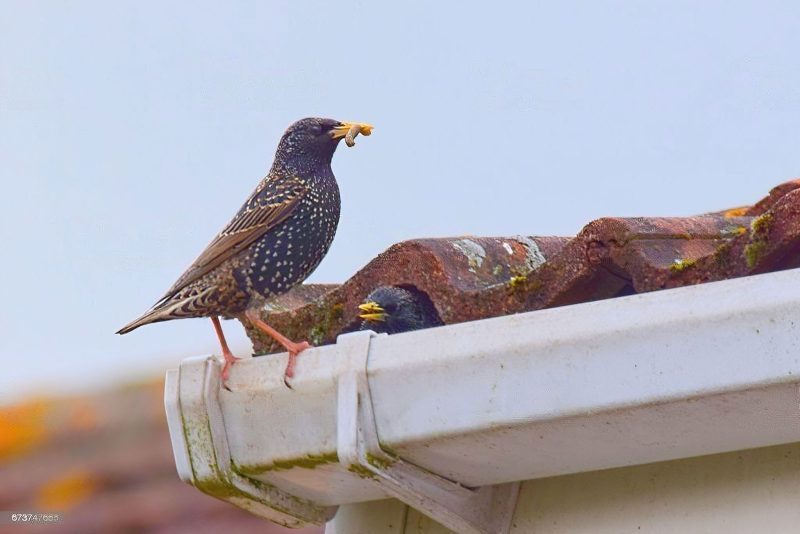How To Keep Animals Off Your Roof? – 9 Easy Methods
Roofs offer a strong, warm, easily accessible and safe environment for animals and birds to live in and breed. Moreover, when animals start to make a home out of your roof. They often infiltrate the attic, chew through the wood, break the shingles/ tiles, cause leaks, defecate, urinate and leave a mess.
How To keep animals off your roof? You can check your chimneys, use animal repellents, regularly inspect your attic, clean the gutters, trim the trees and keep trash away from your home.
However, these methods need the proper implementation to work. The article below explains how to execute each tip, in great detail, while considering your safety. Plus, it also highlights, what roof damage is caused by which animal.
5 Common animals and birds that damage your roof. What do they do? : How To Keep Animals Off Your Roof?
If you have been hearing noises in your attic, do not worry! Your house isn’t possessed. It’s just animals trying to share a living space with you.
Over the years with increasing infrastructure. Different animals and birds have evolved to use the roof and attic as their breeding ground cum living space.
However, it may be tough to identify which animal or bird is intruding in your home. Below are some common animals and birds that tend to live on roofs and in attics. Along with the signs to recognize them.
1) Raccoons:
Raccoons love to dig through cedar roofs in spring to give birth. They are extremely sneaky and fast.
To be sure that you have raccoons living in your attic look for:
- Holes in the external layer of the roof.
- Footsteps, thumping and snarling noises.
- Scratch marks on the woodwork.
- Regular siting of raccoons on your roof and in the surrounding area.
2) Seagulls, Woodpeckers and other birds:
Birds only build nests during nesting season. Especially, seagulls.

- Pecking through single-ply flat roof membranes while breaking apart their food.
- Flapping and rustling noises.
- Nesting materials are scattered close to the house and on the roof.
- Irritated or itchy pets. (Pets are great at spotting another animal in their living space)
- Pecking through siding allows water infiltration into the home, leading to leaks.
Are all the signs of birds nesting in your attic.
3) Squirrels/ Rodents:
Squirrels just like raccoons are quick. But unlike raccoons, they are most active in the morning and the evening.
Look for:
- Nests in the attic, nesting materials around the house and on the roof.
- Hearing strange squeaky and thumping sounds. Mostly around dawn and in the evening.
- Scratches on the woodwork.
- More squirrels around your property.
- A foul odour.
4) Bees:
Bees are entirely a different ballgame and need to be handled with utmost care and safety. It’s common to spot bees if you have a garden or trees around your home.
However, be alert if you notice;
- Black lumps hanging off your roof shingles/tiles, or the edges of your roof.
- More bees buzzing around your home than usual.
Note: In case of bee infestations, do not try any DIY techniques. Always put the safety of you and your family first. Let the professionals handle it.
9 easy ways | How to keep animals off your roof:
Check Your Chimneys:
Chimneys are nothing but a red carpet entrance to your home. Especially, when it’s spring, it’s considerably warm. Chimneys are of no use this time of the year. Which is exactly the time when most animals reproduce. They locate a chimney and through it get into your roofing system and even in your home.
Just like the attic and vents, an unused chimney offers a warm, protected and cozy place for animals to raise their younglings. Regular inspection and maintenance of your chimney are a must. Even if you conduct roof maintenance annually, clean your chimney every 3-4 months.
Chimney caps can be used to solve this problem of animal infestations. As they have a mesh screening that prevents animals from entering.
Chimney caps also have additional benefits as they keep snow and water away from your chimney, avoiding leaks. Sparks do not escape your chimney if a chimney cap is installed, ruling out any possibility of fire hazard.
Keep Animal Repellent Handy:
Use chemical animal repellents to keep animals away from your home works. Animals can’t tolerate substances like essential oils, pepper, garlic, tarragon, etc. These repellents are made to duplicate the smell of these substances and sometimes even contain the urine of predators to repel pests off the roof.
These repellents come in solid, liquid as well as spray forms. Making them easy to use. You can place or spray these repellents in the areas where the animals are most active. Or on the entry points to your roof, depending on which place is accessible.
Keep an eye on your attic:
While the chimney may provide free access to the roof. The attic is where most animals choose to live. Because.
- It’s mostly uninterrupted by humans and other animals.
- It has the perfect temperature.
- It’s spacious for all newborns.
- It’s easy to get in and out of the attic.
However, once the critters settle in your attic it’s difficult to get them out.
Start by inspecting the exterior of your attic. You should be looking for the tale tells of forced entry, animal-sized holes, chewed wood, broken shingles or tiles and animal droppings. This will help you spot the entry point through which the animals enter and exit, the attic.
Next, inspect the interior. Look for similar signs. Plus, damaged wires, wet spots, and signs of nests.
Use a flashlight and a face mask as inhaling insulation fibres and fecal matter is dangerous.
You may even discover a nest with baby animals. In such situations, it’s best to call professionals to handle the situation without causing harm to anything.
Shut The Trash Cans:
Trash equals easy food. Animals like raccoons, squirrels and skunks, love to get into places they do not belong. Exposed trash, uncovered dustbins, and piles of compost offer easy meals to these animals.
Make sure the trash cans are either tight shut or use heavy-duty lids. Place them slightly away from your home, to prevent animals from climbing up your roof.
Dropped vegetables and fruits from plants and trees should not litter your premises, as it attracts rodents. If you feed your pets outside the home, make sure to bring back their food bowls inside, after every meal.
These small steps make your home much more unattractive to animals, as there are hardly any food sources near it.
- Use motion sensor lights.
- Know the mouth of your trash bags inside the trash cans.
- Spray or place animal repellents around in and around your trash cans.
Clean your gutters:
Gutters often collect a lot of dirt. Moss, dried leaves, twigs, animal droppings, etc slid off the roof and accumulate in the gutters. Furthermore, the gutter is shaped to support bird nests.
Birds and other small animals tend to block the gutters. Regularly cleaning your gutters will help you to clear the intrusion in its early stages.
If you do not have the time to regularly clean the gutters use gutter guards. It will prevent debris from collecting in the gutter.
Clogged gutters lead to leaks and excess weight on the roof.
Trim The Trees Around Tour Home:
Naturally, animals and birds are meant to live in the trees. When branches loom over your home. These animals get access to your rooftop, with the branches acting as ladders and bridges.
Trim off the overhanging branches, and maintain at least 6-8 feet of distance between the tree limbs and your home. Raccoons, squirrels, etc. cannot jump beyond 6 feet. This will not only guard your home from animals. But also, from the trees themselves. Branches often break due to age, or during storms.
This may damage your roof. Plus, dried leaves and twigs collect on your roof, if the branches are too close.
Use Animal Feeders:
If you love feeding animals and birds other than your pet, use an animal feeder. However, do not hang or place it anywhere near your home.
Many people hang bird feeders on their decks or scatter grain over their roofs. This attracts animals to your roof. And inviting the critters to your house is as good as inviting roofing problems.
Choose a spot on a far tree and attach the bird/animal feeders there. This will effectively keep animals off your rooftop and mostly contain them in the areas around the feeder.
Periodic Pest Control:
While talking about animals and birds we cannot forget, the vermin. Cockroaches, mice, rats, roaches, etc. infest the house too.
Sadly, hardly any of the above approaches are helpful to rid your home of its infestation. If you suspect your home or a certain part of your home is overrun by pests, conduct a professional inspection.
Later, you can have pest control, to terminate these vermin.
This will prevent further infestation and kill all the present pests nested in your home.
Get Professional Help: (How To Keep Animals Off Your Roof)
Getting a hold of raccoons, squirrels, rats or other pests living on your roof or in your house is tough. Many a time it’s dangerous to catch these animals without proper equipment or prior experience.
Hiring a good roofer is the best way, to quickly and efficiently remove these animals and birds off your property. Moreover, roofers can suggest some advanced preventive measures to avoid the same situation in the future.
Conclusion:
I hope this article “How To Keep Animals Off Your Roof”, gives you a good idea of how to spot animal intrusion in your homes. And how to prevent or terminate it.
Have further questions? Wish to add to the article? Feel free to comment.
If your home is currently under an animal attack, our professional team will be at your doorsteps in just one call.
LeakStop is a one-stop destination to meet your roofing-related requirements. We offer roof repair, replacement, maintenance and inspection services all over GVRD (Greater Vancouver Regional District).
We offer a free inspection to first-time clients. Connect with us TODAY at 1 866 777 0084 for immediate assistance!
